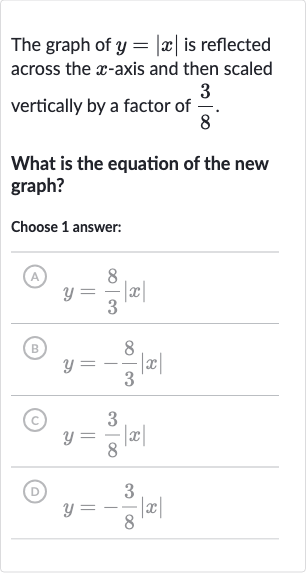Full solution
Q. The graph of is reflected across the -axis and then scaled vertically by a factor of .What is the equation of the new graph?Choose answer:(A) (B) (C) (D)
- Reflection across x-axis: Reflecting the graph of across the x-axis means we need to multiply the function by , because reflection across the x-axis changes the sign of the -values.
- Scaling vertically by : The reflection of across the -axis is .
- Final equation after transformations: Next, we need to scale the reflected graph vertically by a factor of . This means we multiply the entire function by .
- Final equation after transformations: Next, we need to scale the reflected graph vertically by a factor of . This means we multiply the entire function by .Scaling by a factor of gives us the new function .
- Final equation after transformations: Next, we need to scale the reflected graph vertically by a factor of . This means we multiply the entire function by . Scaling by a factor of gives us the new function . Simplify the expression to get the final equation of the new graph. Multiplying by gives us .
- Final equation after transformations: Next, we need to scale the reflected graph vertically by a factor of . This means we multiply the entire function by .Scaling by a factor of gives us the new function .Simplify the expression to get the final equation of the new graph. Multiplying by gives us .The final equation of the new graph after the transformations is .

